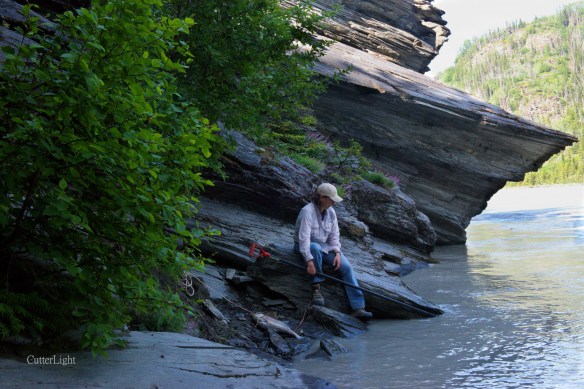A two-mile hike into the canyon, a scramble down a steep bank, a piece of river with no one else in sight, and a run of red salmon hugging the shoreline, pushing upstream, heading home…
Chalky-brown with glacial silt and bank erosion, the broad river sweeps by below, swift, powerful, wild. If we’ve timed it right, the piece of water we’ve chosen to fish will be full of sockeyes. Fireweed has just begun to bloom, and the forest trail above the river is lined with bluebells and pink wild roses.
Barbra fishes an eddie where the fish swim close to the bank on their journey to spawning grounds further upstream.
This is not the fishing of hackle and thread carefully presented on graceful, arcing casts, nor even of Pixie spoons heaved out and fluttered through clear riffles. The net our friend Nathaniel Wilder has loaned us measures roughly three feet across and four feet long and is attached to a 12-foot handle. The rig is cumbersome, made more so by the surging tug of the current and we take turns bracing the handle against a slate rock outcropping to keep it steady in the river’s flow. When a fish hits, the net comes to life.
With a salmon in the net, the scramble for solid footing begins.
 Left: On average the hens are smaller, but the roe is a delicacy.
Left: On average the hens are smaller, but the roe is a delicacy.
They come one, two and even three at a time and average six pounds apiece. The limit is 30, and it’s quickly apparent it won’t take long to put that many on the bank. A small, ice-cold stream cascading down the canyon wall provides the perfect place to clean the catch. We’re happy to have packed in a scrap of wood to serve as a filleting table.
The two-mile hike back to our camper, our backpacks loaded with 90 pounds of fish between the two of us is work, but a good kind of work. Back home, we’ll smoke and can the bright red fillets. The roe we’ve kept will be cured and made into ikura.
 Brilliant red-orange and marbled with fat, these sockeye fillets are ready to be brined and smoked, seasoned and broiled, grilled on a cedar plank, or sliced thin and served as sashimi. As per standard practice in Japanese sushi shops, we freeze salmon (and other fish) for at least 24 hours prior to preparing raw.
Brilliant red-orange and marbled with fat, these sockeye fillets are ready to be brined and smoked, seasoned and broiled, grilled on a cedar plank, or sliced thin and served as sashimi. As per standard practice in Japanese sushi shops, we freeze salmon (and other fish) for at least 24 hours prior to preparing raw.
Warm weather in Alaska has meant quickly melting ice and high water.

Above left: Bluebells, horsetail ferns and salmonberries take over the ruins of an old train trestle. Right: Dense patches of wild rose perfume the air along the trail. Below: We hiked out of the canyon at midnight, just as the Alaskan sun was setting.
For an excellent recipe for brining and smoking salmon, see: Smoked Salmon with Soy Sauce and Brown Sugar Brine
For an easy ikura curing method, see: Ikura: Curing Salmon Eggs







Great shot, Bar!
Thanks BK!
Wow! Gorgeous pictures and beautifully written. Felt like I was right there with you!
Thanks a lot Robyn!
Looks like a great place!
Paradise! Thanks for reading.
I hate you, yet I love you! My mouth is watering.
Come back and visit! You’d have been proud of the fillet job I did on those fish… Though I imagine you’d have had ’em done in half the time!
Wow! Happy did see no one fell in…Hahahaha and The Bald Eagle pic knocked it out of the park for me. Awesome shot! Thanks for sharing. 🙂
Thanks! It was a day for the books!
Delightful pictures that conveyed the sights, and almost evoked the sounds of that spot. The senses of smell and taste are ever present in your recipes.
Thanks much for the encouraging words!
Reblogged this on Musings of a Penpusher and commented:
The photographs evoke the sights, and it’s almost possible to hear the sounds of that spot. The recipes of these folk do so much for the taste buds of their readers.
Hope you don’t mind; I reblogged this one.
Thanks for the reblog Maureen!
I’ll be up there this weekend hoping to stock the larder for the winter again. Do you also dip at Kenai/Kasilof? I’ve noticed those fish are not as large or as deeply colored. Likewise, they seem a bit less flavorful.
Good luck, Phil. The Copper River fish are exceptional on the table. We haven’t been on the Kenai yet. Of course, a lot depends on how far up river the fish are, too. Thanks for the comment!
Wonderful post. I love those cliffs in three first photos – great.
Climbing back up those cliffs with our packs full of fish was a workout!
Enjoyed your photos. It reminded me of the great times I have had there catching fish. I fished there for over 30 years. Now in Arizona.
It’s a special place indeed. Thanks for the comment, Bob.